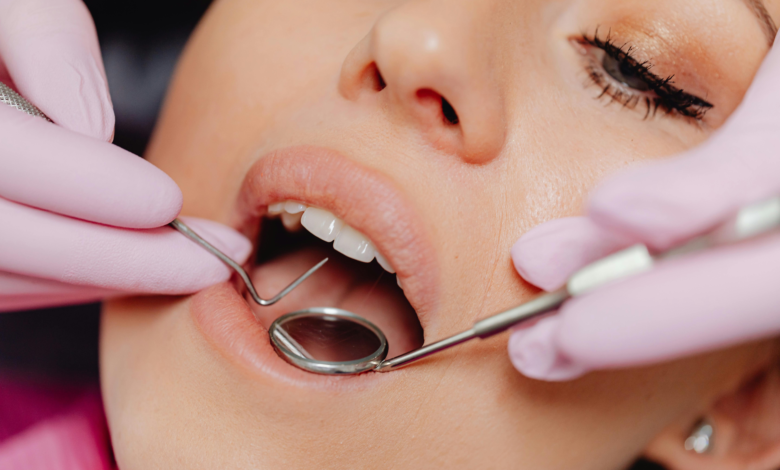Nine Common Dental Problems and Possible Treatments

Dental health is a vital aspect of overall well-being, yet it is often overlooked until problems arise. In Canada, dental issues are particularly prevalent, with statistics revealing that 59% of 12-19-year-olds have experienced cavities. This alarming figure highlights the importance of being informed about common dental problems and their treatments. Understanding these issues not only helps in managing current dental health but also plays a crucial role in prevention.
This article will explore ten common dental problems and provide insights into effective treatments, ensuring you are well-equipped to maintain optimal oral health.
1. Gum Disease (Gingivitis and Periodontitis)
Gum disease is another common dental issue, which can progress through various stages, starting with gingivitis and potentially advancing to periodontitis if left untreated. Gingivitis involves inflammation of the gums, causing them to become red, swollen, and prone to bleeding. The common cause of this disease is poor oral hygiene, which leads to plaque buildup.
Treatment options include professional cleaning, scaling, and root planing to remove plaque and tartar from above and below the gum line.
2. Cavities
Did you know that 96% of adults in Canada reported having had cavities at some point in their lives? Cavities, also known as dental caries or tooth decay, are among the most common dental problems. They occur when plaque, a sticky film of bacteria, forms on the teeth and breaks down sugars into acids. These acids erode the enamel, creating holes or cavities in the teeth.
Cavities are usually treated by removing the decayed portion of the tooth, which is then filled by your dentist with materials such as amalgam, composite resin, or gold. Before the actual filling, however, a temporary tooth filling might be used. Temporary fillings provide a short-term solution to protect the tooth until a permanent filling can be placed. They are made from materials that can easily be removed, such as zinc oxide eugenol, and are particularly useful when multiple visits are required to complete the treatment.
3. Tooth Sensitivity
Tooth sensitivity affects many people, causing discomfort or pain when consuming hot, cold, sweet, or acidic foods and beverages. It occurs when the underlying layer of the teeth, called dentin, becomes exposed due to enamel erosion or gum recession.
Treatment for tooth sensitivity involves using desensitizing toothpaste that contains compounds that block the pathways to the nerves in the teeth, reducing sensitivity. Fluoride treatments can also help by strengthening the enamel and reducing the sensation. In more severe cases, dental procedures such as bonding, crowns, or inlays may be necessary to cover exposed dentin and protect the teeth.
4. Tooth Erosion
Tooth erosion is the loss of tooth enamel caused by acid attack. Unlike cavities, which are caused by bacterial acids, tooth erosion is often the result of dietary acids from foods and drinks, such as soda, citrus fruits, and vinegar.
Symptoms of tooth erosion include sensitivity, discoloration, rounded teeth, and transparent edges. Treatment focuses on restoring the lost enamel and protecting the remaining tooth structure. Dental bonding, where a tooth-colored resin is applied to the eroded areas, can help restore the appearance and function of the teeth.
5. Bad Breath (Halitosis)
Bad breath, or halitosis, is a common and often embarrassing problem. It can result from poor dental hygiene, certain foods, smoking, or underlying health issues. The bacteria in the mouth break down food particles, releasing foul-smelling compounds.
Improving oral hygiene is the first step in treating bad breath. Regular brushing, flossing, and using mouth rinses can help reduce the bacteria and food particles that cause odor. Professional dental cleaning can remove plaque and tartar that harbor bacteria. In some cases, treating underlying conditions such as gum disease or dry mouth may be necessary to address persistent bad breath.
6. Toothaches
Toothaches are a common dental issue characterized by pain in or around a tooth. They can result from various causes, including tooth decay, abscessed teeth, gum disease, damaged fillings, or a fractured tooth.
When experiencing a toothache, it’s essential to consult a dentist to determine the underlying cause. Treatment options vary depending on the diagnosis. For cavities, a filling or crown may be necessary. If the tooth’s pulp is infected, a root canal treatment might be required to remove the infection and save the tooth. In cases of severe damage or decay, tooth extraction may be the only viable option. Over-the-counter pain relievers can provide temporary relief, but professional treatment is crucial for long-term resolution.
7. Crooked Teeth and Malocclusion
Crooked teeth and malocclusion, or misaligned bite, are common dental issues that can affect both aesthetics and function. They can result from genetic factors, early loss of baby teeth, thumb-sucking, or injury.
Orthodontic treatment is the primary method for correcting crooked teeth and malocclusion. Traditional braces, consisting of metal brackets and wires, gradually shift teeth into their proper positions. Clear aligners, like Invisalign, offer a more discreet option for teeth straightening. In some cases, retainers are used to maintain alignment after the initial treatment. Early intervention in childhood can prevent more severe issues, but orthodontic treatment can be effective at any age.
8. Tooth Decay in Children
Tooth decay is a common problem among children, primarily caused by poor oral hygiene and a diet high in sugary foods and drinks. Baby teeth are more susceptible to decay because their enamel is thinner than that of permanent teeth.
Preventive measures are crucial in managing tooth decay in children. Parents should encourage regular brushing and flossing, limit sugary snacks and drinks, and ensure regular dental check-ups. Fluoride treatments can strengthen tooth enamel and make it more resistant to decay. Dental sealants, which are thin, protective coatings applied to the chewing surfaces of back teeth, can also help prevent cavities in children.
9. Impacted Teeth
Impacted teeth occur when a tooth fails to emerge fully from the gums, often due to overcrowding or abnormal positioning. Wisdom teeth are the most commonly impacted, but any tooth can be affected.
Symptoms of impacted teeth include pain, swelling, and infection in the gums around the impacted tooth. Treatment options vary based on the severity of the impaction. In some cases, no treatment is necessary if the impacted tooth is not causing problems. However, if the tooth is causing pain, infection, or damage to adjacent teeth, extraction may be required. Surgical removal is often necessary for deeply impacted teeth, and an oral surgeon typically performs this procedure.
Conclusion
Dental health is a critical component of overall well-being, and understanding common dental problems and their treatments can help maintain a healthy smile. Regular dental check-ups, good oral hygiene practices, and early intervention can prevent many dental problems and ensure optimal dental health. By being aware of these common issues and seeking timely treatment, individuals can protect their dental health and enjoy a confident, pain-free smile.



